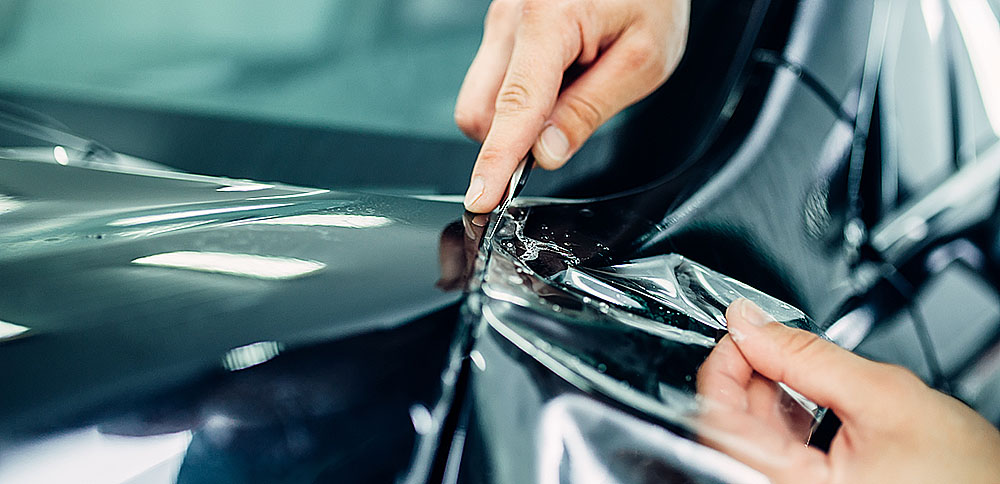Paint protection film or PPF is the ultimate solution to protecting not only the vehicle’s paint against contaminants but also minor scratches. Initially, paint protection films were simply meant to protect and needed replacement if damaged. Now, paint protection films can also self-heal, meaning they have properties that allow the film to return to its original condition using sunlight. We will discuss the similarities and differences between the two to help you make an informed decision.
What Is Non-Self-Healing PPF?
Non-self-healing PPF as the term suggests is a film that does not contain the properties allowing it to self-heal. This is a standard type, which happens to be a lot more common than self-healing PPF. The reason is that self-healing films are quite expensive. The difference here is that non-self-healing PPFs need to be replaced once they are damaged or scratched.
That said, a standard film might cost you less in the initial days but in the long run, it is going to cost you a lot more.
What Is Self-Healing PPF?
Self-healing PPF is a film that is the opposite of the standard PPF film. It is an updated or modern version of the standard film that consists of self-healing properties. This means that if the film tends to get some scratches or damage, the film will heal itself under the sun.
Technically, the film contains special polymers that react to heat. So, if you own an expensive vehicle, investing in a self-healing PPF is going to be worth it. However, self-healing films are expensive to begin with. But since you are not going to need replacement down the road, it is going to be a one-time investment.
How Long Do PPFs Last?
The lifespan of PPFs typically depends on the quality of the material and installation technique. Most people are not aware of the fact that it is not the products but the way the film is applied that makes or breaks your investment. This is why you should always opt for certified retailers and installers.
While looking for authentic films, you will come across many that are being offered at a lower price. You might be tempted to go for it but will only end up wasting money. On the other hand, authentic sellers will quote you a price that is going to be relatively expensive but the film will be covered with a guarantee and warranty.
Secondly, the lifespan is also dependent on the maintenance of the film. Once the film has been installed, you will need to use the right products and techniques to ensure the film does not get scratched or damaged. There have been many incidents in the past where people have used low-quality products and improper techniques that have cost them big time in terms of replacement.
How Are PPF Films Installed?
The installation process of PPF films takes place in multiple stages. To begin with, the vehicle is prepared, meaning it has to undergo an extensive decontamination process. Experts use different products to eliminate dirt, dust, and other factors that directly affect the lifespan of the film.
If these factors are not eliminated, the film will not bond to the vehicle properly. As a result, bubbles will begin to form that will have you going in for a replacement sooner than you think. Once the vehicle is contaminant-free, the paint protection film is cut into sections for different parts of the vehicle.
Using a liquid solution and squeegee, the film is laid on the vehicle ensuring there are no bubbles trapped. Finally, the excess solution is removed and the vehicle is left to cure using UV rays. Keep in mind that newly installed films cannot be exposed to extreme weather conditions unless they are fully cured.
If you have installed a film on your own, you can use a hairdryer to help dry the film faster but the vehicle should remain covered for a few days or weeks depending on the temperature. The curing process takes much longer when the temperature is cold and less time during the hot season. During the curing process, don’t wash or wax your car because water can get into the film and weaken the bond between the film and the car’s body. Moreover, avoid removing any bubbles you see on the film when the film is still curing.
What Are The Advantages Of A Paint Protection Film?
As mentioned earlier, paint protection will protect your vehicle against stone chips, flying debris, scuffs, etc. If you are opting for a self-healing film, your vehicle will look as good as new without any swirls or scratches once it hits the sun. In other words, you will not have to use expensive products daily to maintain it.
On the other hand, a standard film can easily scratch and will develop swirls if an inappropriate technique is used. In addition to the scratches and scuffs, bird droppings and other acids can also ruin the paint. However, if you have a barrier in the form of a film installed, you won’t need to worry about chipped car paint.
This is similar to car window tinting Springfield. They protect your vehicle from UV rays and heat, but they also keep your car’s windows from getting scratched. In case of an impact or accident, tinted car windows might not break in tens and hundreds of pieces.
What Are The Disadvantages Of A Paint Protection Film?
While there are some advantages, paint protection films also carry some disadvantages you need to be aware of. The biggest concern surrounding paint protection films, especially self-healing films is they are expensive. Opting for other car care products like sealants, waxes, and coatings might help but they will not offer any physical protection.
Furthermore, if you run a sale and purchase business, opting for expensive films is not going to give you good returns every time. In most cases, this only works if you are selling a vehicle that is either unique or expensive. But, if you are demanding a few thousand dollars more on a regular vehicle just because it has a film installed, the customers might not be willing to pay for it.
Can We Install A Film On A Repainted Vehicle?
Installing a film on a repainted vehicle is a common practice but not recommended. There is a difference between a paint job that comes from the factory and one that is done from some other source. A vehicle being produced in the factory has to undergo strict quality checks to ensure quality.
However, that is not the case in regular workshops until you have opted for an excellent quality painter. If you install a film on a repainted vehicle, chances are that the paint will be removed as the film is in case of damage or an accident.
So, the best way is to get the film installed as soon as the vehicle is rolled fresh from the showroom floor.
Conclusion
The difference between self and non-self-healing films is simple. However, the decision to opt between the two depends on your budget, vehicle type, and purpose. But make sure you always go for an authentic retailer and paint protection film installer Springfield to avoid your money going to waste.

